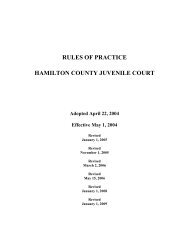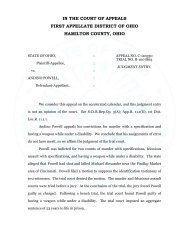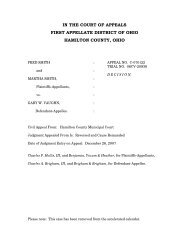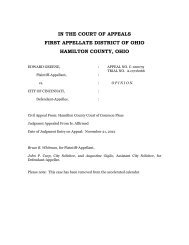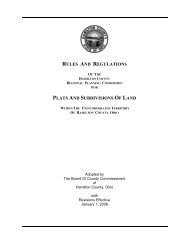State v. Clark - Hamilton County, Ohio
State v. Clark - Hamilton County, Ohio
State v. Clark - Hamilton County, Ohio
Create successful ePaper yourself
Turn your PDF publications into a flip-book with our unique Google optimized e-Paper software.
IN THE COURT OF APPEALS<br />
FIRST APPELLATE DISTRICT OF OHIO<br />
HAMILTON COUNTY, OHIO<br />
STATE OF OHIO,<br />
Plaintiff-Appellee,<br />
vs.<br />
JASHAWN CLARK,<br />
Defendant-Appellant.<br />
:<br />
:<br />
:<br />
:<br />
:<br />
APPEAL NO. C-110137<br />
TRIAL NO. B-0903962-B<br />
JUDGMENT ENTRY.<br />
We consider this appeal on the accelerated calendar, and this judgment entry is<br />
not an opinion of the court. See S.Ct.R.Rep.Op. 2; App.R. 11.1(E); 1st Dist.Loc.R. 11.1.1.<br />
Following a jury trial, defendant-appellant Jashawn <strong>Clark</strong> was convicted of<br />
three counts of felonious assault under R.C. 2903.11(A)(2), one count of improper<br />
discharge of a firearm into a habitation under R.C. 2923.161(A), two counts of having<br />
weapons while under a disability under R.C. 2923.13(A)(3), and two counts of<br />
aggravated murder under R.C. 2903.01(A).<br />
Several of these counts had<br />
accompanying firearm specifications. These convictions resulted from two separate<br />
shootings that occurred over a three-week period in March 2009.<br />
The trial court sentenced <strong>Clark</strong> to two consecutive terms of life imprisonment<br />
without parole for the two aggravated murder convictions, which included a five-year<br />
prison sentence on a firearm specification. The court also sentenced him to an<br />
aggregate prison term of 11 years on the remaining counts and specifications.<br />
<strong>Clark</strong> has a filed a timely appeal from these convictions. He was tried with<br />
two co-defendants, Eric Long and Fonta Whipple, whose convictions we affirmed in
OHIO FIRST DISTRICT COURT OF APPEALS<br />
<strong>State</strong> v. Long, 1st Dist. No. C-110160, 2012-<strong>Ohio</strong>-3052, and <strong>State</strong> v. Whipple, 1st<br />
Dist. No. C-110184, 2012-<strong>Ohio</strong>-2938.<br />
<strong>Clark</strong> raises seven assignments of error for review. In his first assignment of<br />
error, he contends that the trial court erred by overruling his motion to sever the<br />
counts related to the two separate shootings for trial.<br />
He argues that he was<br />
prejudiced because the court permitted those counts to be tried together.<br />
Our review of the record shows that <strong>Clark</strong> was not prejudiced by the court’s<br />
failure to sever the counts related to each shooting because the evidence related to<br />
each shooting was simple and direct and the jury could easily segregate the proof for<br />
each offense. Therefore, the trial court did not abuse its discretion in overruling<br />
<strong>Clark</strong>’s motion to sever. See <strong>State</strong> v. Coley, 93 <strong>Ohio</strong> St.3d 253, 259-261, 754 N.E.2d<br />
1129 (2001); Long at 11-20; Whipple at 13-18. We overrule <strong>Clark</strong>’s first<br />
assignment of error.<br />
In his second assignment of error, <strong>Clark</strong> contends that the evidence was not<br />
sufficient to support his convictions. In his fourth assignment of error, he contends<br />
that the trial court erred in overruling his Crim.R. 29 motions for judgments of<br />
acquittal on all counts, which is a same as a claim that the evidence was insufficient<br />
to support the convictions. See <strong>State</strong> v. Jones, 1st Dist. No. C-080518, 2009-<strong>Ohio</strong>-<br />
4190, 41.<br />
Our review of the record shows that a rational trier of fact, after viewing the<br />
evidence in a light most favorable to the prosecution, could have found that the state<br />
had proved beyond a reasonable doubt all the elements of felonious assault, having<br />
weapons while under a disability, improper discharge of a firearm into a habitation<br />
and aggravated murder.<br />
Therefore, the evidence was sufficient to support the<br />
convictions, and we overrule <strong>Clark</strong>’s second and fourth assignments of error. See<br />
2
OHIO FIRST DISTRICT COURT OF APPEALS<br />
<strong>State</strong> v. Jenks, 61 <strong>Ohio</strong> St.3d 259, 574 N.E.2d 492 (1991), paragraph two of the<br />
syllabus; Long, 2012-<strong>Ohio</strong>-3052, at 48-49; Whipple, 2012-<strong>Ohio</strong>-2938, at 20-24.<br />
In his third assignment of error, <strong>Clark</strong> contends that his convictions were<br />
against the manifest weight of the evidence. After reviewing the record, we cannot<br />
say that the jury lost its way and created such a manifest miscarriage of justice that<br />
we must reverse <strong>Clark</strong>’s convictions and order a new trial. Therefore, the convictions<br />
are not against the manifest weight of the evidence. See <strong>State</strong> v. Thompkins, 78 <strong>Ohio</strong><br />
St.3d 380, 387, 678 N.E.2d 541 (1997); Long at 41-47; Whipple at 20-24. We<br />
overrule <strong>Clark</strong>’s third assignment of error.<br />
In his fifth assignment of error, <strong>Clark</strong> contends that the trial court erred in<br />
imposing excessive sentences. Our review of the record shows that the sentences<br />
were not contrary to law, or so arbitrary, unreasonable or unconscionable as to<br />
connote an abuse of discretion. Therefore, the trial court did not err in imposing<br />
them, and we overrule <strong>Clark</strong>’s fifth assignment of error. See <strong>State</strong> v. Kalish, 120<br />
<strong>Ohio</strong> St.3d 23, 2008-<strong>Ohio</strong>-4192, 896 N.E.2d 124, 26; <strong>State</strong> v. <strong>Clark</strong>, 71 <strong>Ohio</strong> St.3d<br />
466, 470, 644 N.E.2d 331 (1994); Long at 57-59.<br />
In his sixth assignment of error, <strong>Clark</strong> contends that the trial court erred in<br />
failing to instruct the jury on the lesser-included offense of involuntary manslaughter<br />
and the offense of inferior degree of voluntary manslaughter.<br />
We agree that<br />
involuntary manslaughter under R.C. 2903.04(A) is a lesser-included offense of<br />
aggravated murder under R.C. 2903.01(A) and that voluntary manslaughter under<br />
R.C. 2903.03(A) is an offense of inferior degree. See <strong>State</strong> v. Conway, 108 <strong>Ohio</strong><br />
St.3d 214, 2006-<strong>Ohio</strong>-791, 842 N.E.2d 996, 129 and 132.<br />
But the evidence, even when construed in <strong>Clark</strong>’s favor, was not sufficient to<br />
allow a jury to reasonably reject the greater offense and find him guilty of a lesser-<br />
3
OHIO FIRST DISTRICT COURT OF APPEALS<br />
included or inferior-degree offense. See Id. at 134. Nothing in the record supports<br />
the conclusion that <strong>Clark</strong> acted with any lesser level of intent than prior calculation<br />
and design or that he was under the influence of a sudden fit of passion or rage<br />
brought on by serious provocation by the victims. Therefore, the trial court did not<br />
err in failing to instruct the jury on involuntary manslaughter and voluntary<br />
manslaughter. See Id. at 129-137; <strong>State</strong> v. Thomas, 40 <strong>Ohio</strong> St.3d 213, 216-218,<br />
533 N.E.2d 286 (1988); 216-218; <strong>State</strong> v. Finley, 1st Dist. No. C-061052, 2010-<strong>Ohio</strong>-<br />
5203, 30-31; <strong>State</strong> v. Jackson, 1st Dist. No. C-090414, 2010-<strong>Ohio</strong>-4312, 9. We<br />
overrule <strong>Clark</strong>’s sixth assignment of error.<br />
Finally, in his seventh assignment of error, <strong>Clark</strong> contends that the trial court<br />
erred by allowing the state to present “other acts” evidence. Specifically, he argues<br />
that the trial court should not have allowed a witness testify that he had seen <strong>Clark</strong><br />
possess an assault rifle days before the first shooting. While evidence of other bad<br />
acts is generally inadmissible, Evid.R. 404(B) provides that it may be used to show<br />
motive, opportunity, intent preparation, plan, knowledge, identity or absence of<br />
mistake or accident. <strong>State</strong> v. Lukacs, 188 <strong>Ohio</strong> App.3d 597, 2010-<strong>Ohio</strong>-2364, 936<br />
N.E.2d 506, 37 (1st Dist.).<br />
In this case, the evidence was admissible to prove <strong>Clark</strong>’s identity as one of<br />
the shooters. Further, the evidence described the immediate background of the<br />
charged crimes and was inextricably related to those crimes. Consequently, the trial<br />
court did not abuse its discretion in admitting the testimony into evidence. See<br />
Long, 2012-<strong>Ohio</strong>-3052, at 32; Lukacs at 37-39; <strong>State</strong> v. Hirsch, 129 <strong>Ohio</strong> App.3d<br />
294, 308, 717 N.E.2d 789 (1st Dist.1998). We overrule <strong>Clark</strong>’s seventh assignment of<br />
error and affirm the trial court’s judgment.<br />
4
OHIO FIRST DISTRICT COURT OF APPEALS<br />
A certified copy of this judgment entry is the mandate, which shall be sent to the<br />
trial court under App.R. 27. Costs shall be taxed under App.R. 24.<br />
SUNDERMANN, P.J., HENDON and DINKELACKER, JJ.<br />
To the clerk:<br />
Enter upon the journal of the court on July 25, 2012<br />
per order of the court ____________________________.<br />
Presiding Judge<br />
5



